Related Research Articles

Bruno Richard Hauptmann was a German-born carpenter who was convicted of the abduction and murder of the 20-month-old son of aviator Charles Lindbergh and his wife Anne Morrow Lindbergh. The Lindbergh kidnapping became known as "The Crime of the Century". Both Hauptmann and his wife, Anna Hauptmann, proclaimed his innocence to his death, when he was executed in 1936 by electric chair at the Trenton State Prison.
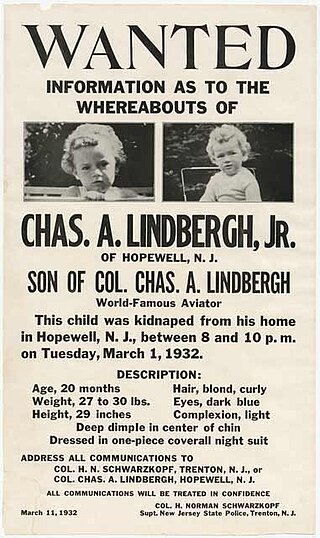
On March 1, 1932, Charles Augustus Lindbergh Jr., the 20-month-old son of aviators Charles Lindbergh and Anne Morrow Lindbergh, was abducted from his crib in the upper floor of the Lindberghs' home, Highfields, in East Amwell, New Jersey, United States. On May 12, the child's corpse was discovered by a truck driver by the side of a nearby road.

Kate Barker, better known as Ma Barker, was the mother of several American criminals who ran the Barker–Karpis Gang during the "public enemy era" when the exploits of gangs of criminals in the Midwestern United States gripped the American people and press. She traveled with her sons during their criminal careers.
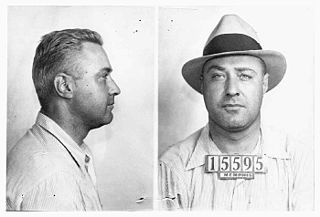
George Kelly Barnes, better known by his pseudonym "Machine Gun Kelly", was an American gangster from Memphis, Tennessee, active during the Prohibition era. His nickname came from his favorite weapon, a Thompson submachine gun. He is best known for the kidnapping of oil tycoon and businessman Charles F. Urschel in July 1933, from which he and his gang collected a $200,000 ransom. Urschel had collected and left considerable evidence that assisted the subsequent FBI investigation, which eventually led to Kelly's arrest in Memphis on September 26, 1933. His crimes also included bootlegging and armed robbery.

Following the historic Lindbergh kidnapping, the United States Congress passed a federal kidnapping statute—known as the Federal Kidnapping Act, 18 U.S.C. § 1201(a)(1) —which was intended to let federal authorities step in and pursue kidnappers once they had crossed state lines with their victim. The act was first proposed in December 1931 by Missouri Senator Roscoe Conkling Patterson, who pointed to several recent kidnappings in the Missouri area in calling for a federal solution. Initial resistance to Patterson's proposal was based on concerns over funding and state's rights. Consideration of the law was revived following the kidnapping of Howard Woolverton in late January 1932. Woolverton’s kidnapping featured prominently in several newspaper series researched and prepared in the weeks following his abduction, and were quite possibly inspired by it. Two such projects, by Bruce Catton of the Newspaper Enterprise Association and Fred Pasley of the Daily News of New York City, were ready for publication within a day or two of the Lindbergh kidnapping. Both series, which ran in papers across North America, described kidnapping as an existential threat to American life, a singular, growing crime wave in which no one was safe.

Alex Rackley was an American activist who was a member of the New York chapter of the Black Panther Party (BPP) in the late-1960s. In May 1969, Rackley was suspected by other Panthers of being a police informant. He was brought to Panther headquarters in New Haven, Connecticut, held captive and tortured there for several days, condemned to death, taken to the wetlands of Middlefield, Connecticut, and murdered there.

The kidnapping of nine-year-old George Weyerhaeuser occurred in 1935 in Tacoma, Washington, United States. The son of prominent lumberman J. P. Weyerhaeuser, George was successfully released for ransom and eventually succeeded his father as the chairman of the Weyerhaeuser company. The four participants in the kidnapping were apprehended and sentenced to prison terms totaling 135 years.

James Ford Seale was a Ku Klux Klan member charged by the U.S. Justice Department on January 24, 2007, and subsequently convicted on June 14, 2007, for the May 1964 kidnapping and murder of Henry Hezekiah Dee and Charles Eddie Moore, two African-American young men in Meadville, Mississippi. At the time of his arrest, Seale worked at a lumber plant in Roxie, Mississippi. He also worked as a crop duster and was a police officer in Louisiana briefly in the 1970s. He was a member of the militant Klan organization known as the Silver Dollar Group, whose members were identified with a silver dollar; occasionally minted the year of the member's birth.
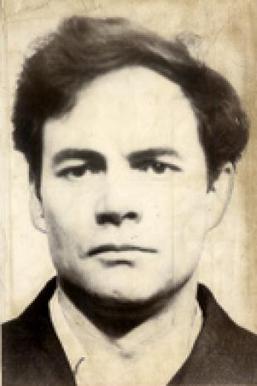
Donald Neilson, alias the "Black Panther," was an English armed robber, kidnapper and murderer. From 1971, he committed a series of robberies of sub-post offices; in 1974, Neilson killed three men during these robberies. In 1975, he kidnapped Lesley Whittle, an heiress from Highley, Shropshire, who died in his captivity. He was arrested later that year, convicted of four counts of murder, and sentenced to life imprisonment in July 1976. Neilson remained in prison until his death in 2011.
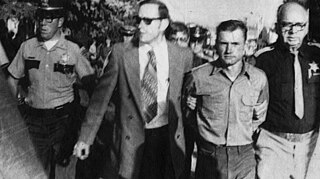
David Gail Meirhofer was an American serial killer who confessed to four murders in rural Montana between 1967 and 1974 — three of them children. Meirhofer killed himself shortly after confessing, and was never tried in court.

Jurijus Kadamovas and Iouri Gherman Mikhel are Soviet-born American serial killers who immigrated to the United States from Lithuania and Russia, respectively. They are currently on federal death row for five kidnappings and murders. The kidnappings occurred over a four-month period beginning in late 2001, in which the kidnappers demanded ransom.

Michaela Joy Garecht was nine years old when she was abducted in Hayward, California, in broad daylight at the corner of Mission Boulevard and Lafayette Avenue.

No Hands on the Clock is a 1941 American comedy mystery film directed by Frank McDonald starring Chester Morris as detective Humphrey Campbell. The cast also included Jean Parker and Rose Hobart. It was produced by Pine-Thomas Productions and released by Paramount Pictures.

The kidnapping and murder of Lesley Whittle occurred on 14 January 1975. Whittle, a teenage heiress, was kidnapped at gunpoint from her home in Highley, Shropshire, by Donald Neilson; a notorious burglar and murderer known as the Black Panther.

The Barker–Karpis Gang was one of the longest-lived criminal gangs during the Depression Era, spanning from 1931 to 1935. The gang was founded by Fred Barker and Alvin Karpis, and later joined by Fred's brother Arthur "Doc" Barker. Along with the three core members, the gang's network spanned up to 25 members at one point.
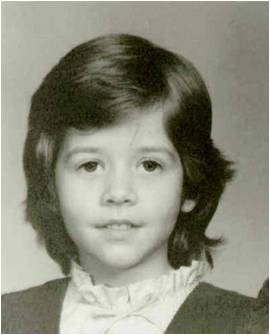
The disappearance of Melissa Brannen occurred on December 3, 1989, at the Woodside Apartments in Lorton, Virginia. The five-year-old daughter of Michael and Tammy Brannen, she was raised by her single mother who lived in the complex. She disappeared while attending a party held at the complex for its residents. Caleb Daniel Hughes, a handyman for the complex, was convicted of abduction with the intent to defile and sentenced to 50 years in prison. Her body has never been found, she has never been proven to be dead, and murder charges have never been filed. The case is considered an unsolved homicide by local police.
James Russell McGregor also known as James 3X, James Shabazz, and Son of Thunder, was a leader of the Black Muslims and an associate of Malcolm X. Shabazz was a minister and spiritual leader of thousands of Muslims in Newark and Jersey City and had been a member of the Nation of Islam, or Black Muslims, for more than 30 years.

Muriel Freda McKay was an Australian woman who was kidnapped on 29 December 1969 in the United Kingdom, and presumed murdered in the first few days of 1970. She was married to Alick McKay, an executive at News Limited and deputy to Rupert Murdoch. She was kidnapped after being mistaken for Murdoch's then-wife, Anna Murdoch. Two Indo-Trinidadian brothers, Arthur and Nizamodeen Hosein, were convicted of McKay's murder and kidnapping in September 1970.
James Bailey Cash Jr. was a five-year-old child from Princeton, Florida who was smothered to death during his kidnapping by Franklin Pierce McCall in 1938.
References
- ↑ Nieves, Evelyn. "Portrait of 2 Accused of Kidnapping: Ardent, Hapless Pursuit of Affluence", The New York Times , June 28, 1992. Accessed October 2, 2007. "Growing up in Hillside, N.J., Arthur Seale and Jackie Szarko were more than comfortable."
- ↑ McQuiston, John T. "Details Given On Suspects In Abduction", The New York Times , June 21, 1992. Accessed December 12, 2018. "After the younger Mr. Seale graduated from Hillside High School in the mid-1960s, he worked briefly as a lifeguard before following his father and joining the Hillside Police Department."
- ↑ Tomlinson, Gerald (1994). Murdered in Jersey. Rutgers University Press. ISBN 978-0-8135-2078-0.
- 1 2 Bovsun, Mara (May 22, 2010). "Ransom gone bad Exxon oil executive Sidney Reso killed in kidnap try by Arthur and Irene Seale". Daily News . New York: Mortimer Zuckerman . Retrieved August 21, 2014.
- ↑ NJ.com, Ted Sherman | NJ Advance Media for (2020-12-14). "Killer involved in 1992 kidnapping and murder of Exxon executive denied compassionate release". nj. Retrieved 2021-06-22.
- ↑ "Find an inmate – Arthur D Seale (Register Number: 15882-050, Located at: Fairton FCI, Release Date: March 24, 2075)". www.bop.gov. Retrieved August 21, 2014.
- ↑ Hanley, Robert (June 29, 1992). "Officials Say Body in Forest Is Sidney Reso". The New York Times . Retrieved August 21, 2014.
- ↑ "Find an inmate – Irene J Seale (Register Number: 15881-050, Released On: November 20, 2009)". www.bop.gov. Retrieved August 21, 2014.